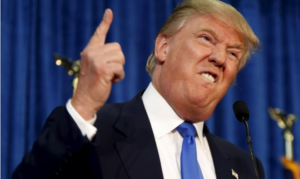In a statement that has reignited fierce debates across the United States, former President Donald Trump recently indicated he might deploy military forces to multiple cities beyond Los Angeles to curb ongoing civil unrest and protests. The announcement comes amid escalating tensions over federal immigration enforcement actions and growing nationwide demonstrations, highlighting the fraught intersection of law enforcement, civil liberties, and executive authority.
Background: Los Angeles as the Flashpoint
The current controversy traces back to a series of federal immigration raids in Los Angeles, which provoked large-scale protests across the city. In response to what he described as widespread “lawlessness,” Trump authorized the deployment of approximately 4,000 National Guard troops alongside 700 Marines to the city to restore order and protect federal facilities. The military presence, which was described by Trump as “the first, perhaps, of many,” has become a flashpoint for broader national debates about the militarization of responses to civilian protests.
The federal government’s move was met with immediate resistance from California’s political leadership. Governor Gavin Newsom swiftly filed a lawsuit asserting that the deployment violated the Posse Comitatus Act, a century-old law that prohibits the use of federal military personnel for domestic law enforcement. A federal judge later ruled in favor of Governor Newsom, ordering the return of the National Guard troops to state control and underscoring the legal limits on federal military intervention in local matters.
Trump’s Position: A Firm Stance on “Law and Order”
Trump’s rhetoric has emphasized a need for strong measures to maintain public order and enforce federal laws, especially regarding immigration. He has characterized the protests as driven by “anarchists” and “criminals,” suggesting that without a robust federal response, cities would descend into chaos. “If it spreads to other cities,” Trump said in a recent interview, “we have to be prepared to send in the military, to protect American citizens and their property.”
This posture reflects Trump’s long-standing “law and order” platform, which he championed during his presidency and continues to espouse in his political discourse. Supporters argue that his approach is necessary to confront what they see as escalating violence and disrespect for the rule of law. They claim that federal intervention is justified when state or local governments fail to control unrest or protect constitutional rights.
Legal and Constitutional Challenges
However, the prospect of using military forces on American streets raises complex legal and constitutional questions. The Posse Comitatus Act of 1878 was enacted to prevent the federal government from using the military as a domestic police force, a principle widely upheld to protect civil liberties and prevent abuses of power. Exceptions exist, such as the Insurrection Act, which allows the president to deploy troops in certain circumstances like insurrections or when state governments request assistance, but its use is highly scrutinized.
Legal experts warn that a broad deployment of military personnel to multiple cities could trigger a constitutional crisis. “The military is trained for combat, not policing,” says Professor Linda Martinez, a constitutional law scholar at Georgetown University. “There is a very real risk of escalating violence and infringing on citizens’ rights if troops are used indiscriminately for domestic law enforcement.”
The federal judiciary has already weighed in, with courts affirming limits on federal military involvement in local affairs. Governor Newsom’s lawsuit was a landmark case emphasizing the balance of powers between state and federal authorities. It also underscored the crucial role of civilian oversight in policing and the dangers of military involvement in civilian matters.
Public Reaction: Divided and Heated
Public opinion on Trump’s potential military deployments is sharply divided. Polls show that a significant portion of the American population supports stronger federal action to quell protests, particularly among conservatives and those concerned about rising crime rates. Conversely, civil rights organizations, liberal activists, and many moderate voters view the militarization of protests as a dangerous overreach.
“It sets a terrifying precedent,” says Aisha Khan, director of the American Civil Liberties Union’s policing reform program. “Deploying troops to suppress protests risks violating constitutional protections like free speech and assembly. It blurs the line between democracy and authoritarianism.”
Protesters themselves argue that the federal response is disproportionate and escalates tensions unnecessarily. In cities like Los Angeles and Chicago, activists report increased confrontations with military personnel, fueling fears of violent crackdowns rather than constructive dialogue.
Broader Context: A Nation at a Crossroads
Trump’s statements about deploying military forces must also be seen within a broader national context. The United States has experienced a wave of protests over the past decade, ranging from racial justice demonstrations to anti-government rallies. The increasing use of law enforcement militarization and federal intervention in protests has intensified debates over civil rights, police reform, and the role of government.
Additionally, immigration enforcement remains one of the most contentious issues in American politics. Federal immigration raids, often coordinated with local law enforcement, have sparked protests due to concerns over racial profiling, family separations, and human rights violations. The deployment of military troops to enforce immigration laws in urban areas marks a significant escalation that many view as politically charged.
What’s Next?
As Trump signals potential military deployments beyond Los Angeles, the nation watches closely. Legal battles are likely to continue, with state governments, civil rights groups, and federal authorities clashing over the limits of executive power. Congress may also become involved, debating whether to reform or clarify laws like the Posse Comitatus Act and the Insurrection Act to address modern challenges.
Meanwhile, the cities targeted for possible deployments face uncertainty. Leaders must balance demands for public safety with protecting civil liberties and maintaining community trust. The challenge of managing protests in a deeply polarized society has never been greater.
For Trump, the issue represents both a policy stance and a political strategy. By positioning himself as a defender of “law and order,” he appeals to a core segment of his base while provoking opponents who fear the erosion of democratic norms. How this dynamic plays out will shape not only the future of American protest movements but also the broader landscape of governance and civil rights in the years to come.







